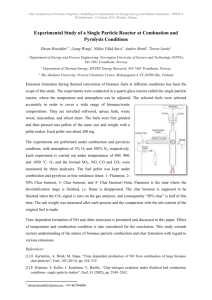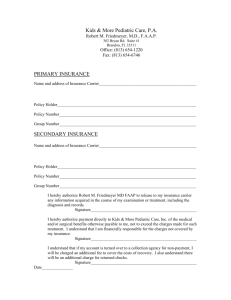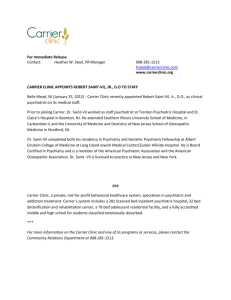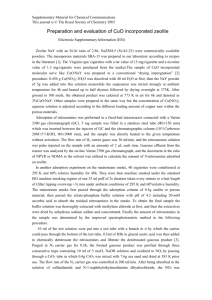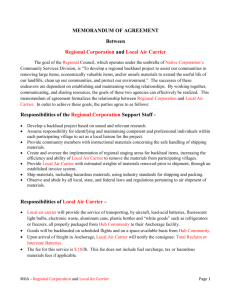introduction - Consiglio Nazionale delle Ricerche
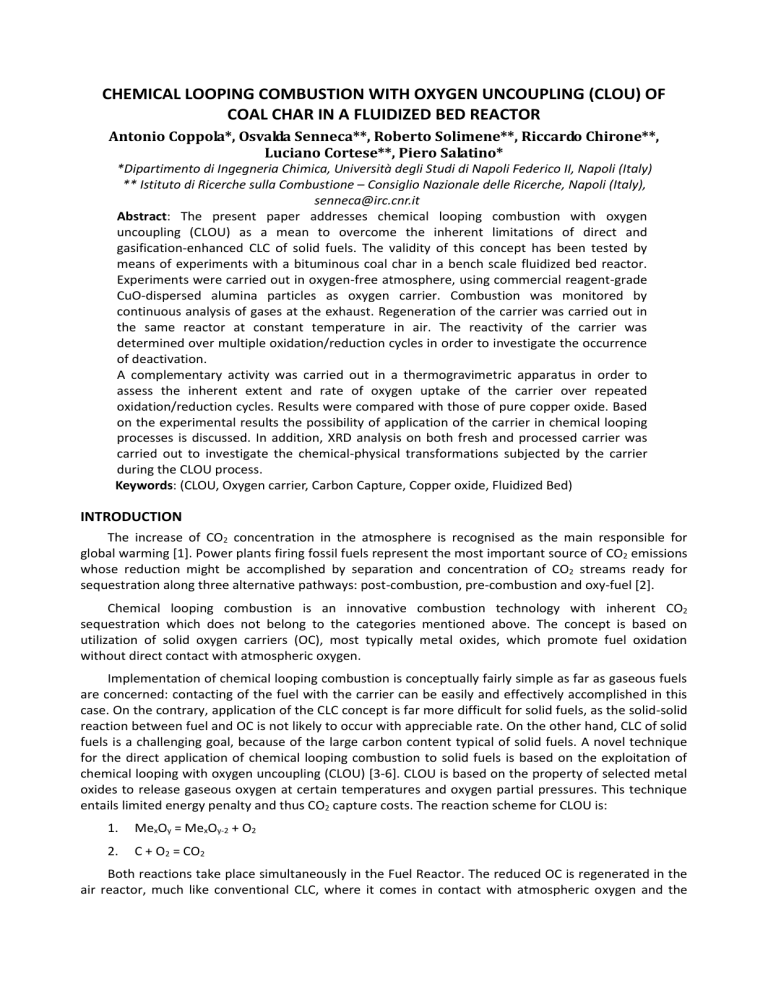
CHEMICAL LOOPING COMBUSTION WITH OXYGEN UNCOUPLING (CLOU) OF
COAL CHAR IN A FLUIDIZED BED REACTOR
Antonio Coppola*, Osvalda Senneca**, Roberto Solimene**, Riccardo Chirone**,
Luciano Cortese**, Piero Salatino*
*Dipartimento di Ingegneria Chimica, Università degli Studi di Napoli Federico II, Napoli (Italy)
** Istituto di Ricerche sulla Combustione – Consiglio Nazionale delle Ricerche, Napoli (Italy), senneca@irc.cnr.it
Abstract: The present paper addresses chemical looping combustion with oxygen uncoupling (CLOU) as a mean to overcome the inherent limitations of direct and gasification-enhanced CLC of solid fuels. The validity of this concept has been tested by means of experiments with a bituminous coal char in a bench scale fluidized bed reactor.
Experiments were carried out in oxygen-free atmosphere, using commercial reagent-grade
CuO-dispersed alumina particles as oxygen carrier. Combustion was monitored by continuous analysis of gases at the exhaust. Regeneration of the carrier was carried out in the same reactor at constant temperature in air. The reactivity of the carrier was determined over multiple oxidation/reduction cycles in order to investigate the occurrence of deactivation.
A complementary activity was carried out in a thermogravimetric apparatus in order to assess the inherent extent and rate of oxygen uptake of the carrier over repeated oxidation/reduction cycles. Results were compared with those of pure copper oxide. Based on the experimental results the possibility of application of the carrier in chemical looping processes is discussed. In addition, XRD analysis on both fresh and processed carrier was carried out to investigate the chemical-physical transformations subjected by the carrier during the CLOU process.
Keywords: (CLOU, Oxygen carrier, Carbon Capture, Copper oxide, Fluidized Bed)
INTRODUCTION
The increase of CO
2
concentration in the atmosphere is recognised as the main responsible for global warming [1]. Power plants firing fossil fuels represent the most important source of CO
2
emissions whose reduction might be accomplished by separation and concentration of CO
2
streams ready for sequestration along three alternative pathways: post-combustion, pre-combustion and oxy-fuel [2].
Chemical looping combustion is an innovative combustion technology with inherent CO
2 sequestration which does not belong to the categories mentioned above. The concept is based on utilization of solid oxygen carriers (OC), most typically metal oxides, which promote fuel oxidation without direct contact with atmospheric oxygen.
Implementation of chemical looping combustion is conceptually fairly simple as far as gaseous fuels are concerned: contacting of the fuel with the carrier can be easily and effectively accomplished in this case. On the contrary, application of the CLC concept is far more difficult for solid fuels, as the solid-solid reaction between fuel and OC is not likely to occur with appreciable rate. On the other hand, CLC of solid fuels is a challenging goal, because of the large carbon content typical of solid fuels. A novel technique for the direct application of chemical looping combustion to solid fuels is based on the exploitation of chemical looping with oxygen uncoupling (CLOU) [3-6]. CLOU is based on the property of selected metal oxides to release gaseous oxygen at certain temperatures and oxygen partial pressures. This technique entails limited energy penalty and thus CO
2
capture costs. The reaction scheme for CLOU is:
1. Me x
O y
= Me x
O y-2
+ O
2
2. C + O
2
= CO
2
Both reactions take place simultaneously in the Fuel Reactor. The reduced OC is regenerated in the air reactor, much like conventional CLC, where it comes in contact with atmospheric oxygen and the
reverse reaction 1 takes place.
OC suitable for CLOU must meet specific requirements, including ability to reversibly uptake oxygen in the temperature range of interest for combustion, i.e. 800-1200°C. Possible OCs for CLOU are the systems: CuO/Cu
2
O, Mn
2
O
3
/Mn
3
O
4
and Co
3
O
4
/CoO [3]. Among them, CuO shows interesting properties for CLOU, as the equilibrium O
2
concentration is about 0.045 at 950°C. The reactions in the fuel reactor are:
3. 4CuO = 2Cu
2
O + O
2
4. C + O
2
= CO
2
Oxygen release (reaction 3) is endothermic but the global reaction, in stoichiometric conditions between C and OC, is exothermic due to carbon combustion (reaction 4). The reduced OC is regenerated in the air reactor by means of the reverse reaction 3. According to reactions 3 and 4, the stoichiometric molar ratio R=C/Cu=0.25 fixes the maximum amount of carbon that can be oxidized per mole of copper during each cycle. Despite the interesting features of CuO, this OC has some limitations such as its tendency toward agglomeration upon full reduction due to the low melting temperature of elemental copper (1085°C). The use of a support material prevents agglomeration. Among several supports, Al
2
O
3 has received considerable attention [7-16]. However the utilization of Al
2
O
3
as support presents some drawbacks. In fact the OC interacts with the support [6, 7], both in oxidized and reduced form, to form ternary compounds which reduce the active phase according to the following reactions:
5. CuO + Al
2
O
3
= CuAl
2
O
4
6. Cu
2
O + Al
2
O
3
= 2CuAlO
2
Moreover CuO may catalyze the phase change of γ -alumina into another phase, with smaller porosity at temperatures lower than pure Al
2
O
3
.
The aim of the present study is the development of a protocol for the characterization of oxygen carriers suitable for application to CLOU of solid fuels. A combination of TG analysis and experiments in a bench scale fluidized bed reactor is directed to characterize of the extent and rate of oxygen uptake in the regeneration stage, of the rate of reversible oxygen release during the desorption stage, of the influence of iterated reduction/oxidation cycles on the reactivity of the OC. The experimental protocol has been set up and tuned by applying it to a commercial reagent-grade oxygen scavenger.
EXPERIMENTAL
The material used for the tests was a commercial (Sigma-Aldrich) oxygen scavenger consisting of copper (II) oxide (13% by mass) supported on porous alumina. The carrier was supplied as regular particles in the size range 850-1000 μm. Additional samples were produced by grinding and sieving the carrier the cut size 400-1000 μm.
The extent and the rate of oxygen uptake of the carrier over repeated oxidation/reduction cycles was assessed by means of thermogravimetric analysis in a TG/DSC apparatus NETSCH 409C/CD, equipped with on-line NDIR gas analyzer (ABB AO2020 Uras 14). Approximately 30mg of carrier were loaded into the TGA and heated in a flow of 100% nitrogen (200ml/min) up to the desired desorption temperature T at the heating rate of 10-50°C/min. The sample was then kept in nitrogen for a time t d
, before the gas was switched over from nitrogen to synthetic air. After oxidation for time to the gas was again switched to nitrogen. Desorption and oxidation steps were iterated several times. During the experiments the weight loss and uptake as well as the CO and CO
2
concentrations at the exhaust were continuously monitored. The temperature in the experimental campaign was varied in the range 600-1000°C while the duration of the oxidation/desorption steps varied in the range 10-100min.
The performance of the carrier in a CLOU process was demonstrated in a lab scale fluidized bed reactor against combustion of a South African char. The char was obtained by devolatilization in a fluidized bed at 850°C for 5 min of mm-sized coal. Char properties are given in Table 1. Char was
eventually ground and sieved to the cut size 400-1000 μm. A quartz reactor with 30 mm ID was used for the experiments. It consisted of two sections: a) the preheater/premixer of the fluidizing gas, 0.36 m high; b) the fluidization column, 0.42 m high. The reactor is equipped with a porous plate and it is electrically heated with two semi-cylindrical ovens. The batch-wise feeding device consists of a hopper and a double-valve system. It is located at the top of the fluidization column and it is used to feed batches of char particles to the reactor in leak-tight conditions. A type-K thermocouple located 10mm above the gas distributor is used to measure and control bed temperature. Fluidizing gas is metered to the reactor via two mass flowmeters/controllers. Downstream of the reactor, a fraction of the exhaust gas is continuously sampled to measure CO, CO
2
and O
2
concentrations by analyzers in order to monitor the progress of reactions. Concentration signals are logged on a PC at a sampling rate of 1 Hz.
Table 1. Proximate and ultimate analysis of the coal char
Proximate
Analysis
% w
Ultimate Analysis
(on dry basis)
% w
Moisture
Volatile Matter
Ash
Fixed Carbon
3.34
7.04
20.45
69.17
Carbon
Hydrogen
Nitrogen
Sulphur
Ash
Oxygen
71.92
1.37
1.48
0.52
20.45
4.26
FB experiments consisted of the following steps: i) Step 1 (sample heating up). Approximately 30 g of carrier were initially loaded into the reactor and heated in a flow of air (200 Nl/h) up to the desired temperature T; ii) Step 2 (char conversion). The fluidizing gas was switched over from air to nitrogen, 30s after the switch, a batch of 0.35 g of char was loaded into the reactor via the feeding device. The loading delay of 30 s was needed to avoid partial combustion of the char with the residual oxygen in the reactor after switch-over. The duration of the delay was selected on the basis of the analysis of the transient response of the reactor to step-wise switch of the fluidizing gas. The bed was kept in nitrogen for a time interval t d
; iii) Step 3 (regeneration of the carrier). The gas feeding to the FB was again switched over from nitrogen to air. The carrier and any residual char were oxidized for a time interval t o
. Steps 2 and 3 were iterated four times with t d
and t o
. equal to 1h and 0.5h, respectively. An additional test was carried out iterating step 2 and 3 three times with a duration of step 2 of the third cycle of about 4h.
The concentrations of CO and CO
2
at the exhaust were continuously monitored during the experiments.
Notably, the amount of char loaded at the beginning of each char conversion stage (Step 2) corresponded to a value of R=C/Cu=0.5, i.e. nearly twice the stoichiometric ratio consistent with reactions 3 and 4. The choice of operating with excess char combined with the fast rate of the char-oxygen reaction 4 were considered a good basis for assuming that all the released oxygen during step 2 reacted with the char and could be detected as CO
2
and, to a lesser extent, CO at the exhaust.
The oxygen carrier was analyzed by means of XRD using a Bruker D2 Phaser apparatus with Cu anode.
The diffractogram was taken between 2
=5-60° with a scan velocity of 0.05 2
/s and further analyzed by means of the software DIFFRACplus TOPAS and the data base PDF4 minerals. The raw sample was compared with samples after different cycles in order to investigate the chemical-physical transformations undergone by the carrier throughout the CLOU process. Notably all samples were finely ground and evenly spread on the sample holder before the XRD analysis.
RESULTS AND DISCUSSION
TG Analysis : Figure 1 on the right side reports the results of a reference TG experiment carried out with pure CuO obtained by in situ thermal decomposition of copper nitrate. The experiment was carried out at T=925°C. A nicely reversible behaviour is observed over three cycles as far as oxygen uptake/release is concerned. The extent of oxygen uptake/release, nearly 11% of the sample mass, is fully consistent with the stoichiometry of reaction 3, confirming that all the copper participates in the reaction during each cycle. Oxygen release in the desorption stage is nearly complete over 20 min.
Oxygen uptake in the oxidation stage is faster, being nearly complete over less than 10 min. Figure 1 on
the left side reports the results of TG analysis of the commercial carrier, expressed as weight of the sample on a CuO (alumina-free) basis during iterated oxidation/desorption at the temperature of
1000°C. The cyclic uptake and release of oxygen are clearly appreciated by the mass gain/loss profiles, but the rate and extent of oxygen uptake/release are distinctively lower than for pure CuO, despite the higher reaction temperature. When referred to the baseline, weight gains of 4.3, 3.7 and 3.2% are observed over the 45 min duration of the first, second and third oxidation cycles, respectively (to be compared with the theoretical maximum uptake of 10% on a CuO basis). Uptaken oxygen is released during the subsequent 60 min desorption stages. Notably, the cyclic pattern appears to be superimposed to a permanent weight loss of about 2% over 400min. The reason of this weight loss is not certain. It might be attributed to incomplete curing of the scavenger, which was used “as is” or to solid state reactions within the sample. This explanation is supported by analysis of the inserted figure, reporting the weight loss registered as a function of temperature upon heating at a constant rate of 5°C/min in nitrogen. In this figure, indeed, several stages of weight loss can be distinguished respectively below
150°C, around 220°C, 600°C and 820°C.
112
110
108
106
104
Supported CuO
100.0
99.5
99.0
98.5
98.0
Weight % in N
2
97.5
150 250 350 450 550 650 750 850 950
T, °C
CuO
102
100
Air
Air
Air
Air
N
2
Air N
2
N
2
N
2
100
N
2
200
N
2
98
0 300 50 100 150 200 t, min
Figure 1. Results of thermogravimetric analysis of the commercial Cu-alumina oxygen carrier (left) and of pure CuO obtained from thermal decomposition of copper nitrate (right).
400 0
Experiments in the FB reactor: Figure 2A reports the char conversion degree (x char
) as a function of time for 4 reductions (duration 1h) and 3 oxidations (duration 0.5h) and for three different particles sizes
(800-1200, 600-800 and 400-600μm respectively) at the temperature of 950°C. Notably combustion of char produces mainly CO
2
when carrier of particle size 600-800 and 400-600μm is used, whereas a significant amount of char is converted to CO with coarser carrier. In this case the value of x char calculated due to CO
2
only (red dashed line) is reported in addition to the value of x char calculated from CO+CO
2
(red line). It can be observed that the performance of the oxygen carrier deteriorates over repeated cycles. With the 400-600 and 600-800
m particle sizes char conversion over a single step passes from a maximum value of about 0.34 in the first cycle to a value of about 0.28 in the last (against the theoretical maximum value of 0.5 calculated for the test conditions). With coarser particles the decay of char conversion is even more remarkable, with a value of x char
in the last cycle below 0.2. The progressive decay of carbon conversion degree with the number of cycles might be related to phase changes within the support. It is well known, for instance, that the transformation of γ -alumina into α-alumina reduces
OC porosity and hinders oxygen release through the pores. This effect would be even stronger with coarser particles, corresponding to larger values of Thiele number Φ . Ineffective oxygen transport within coarse particles is suggested also by the more extensive production of CO.
0,4
0,3
0,2
0,1
800 - 1200
m
600 - 800
m
400 - 600
m
800 - 1200
m(CO2)
0,0
0 5000 10000 time, s
15000 20000
0,7
0,6
0,5
0,4
0,3
0,2
0,1
0,0
0 5000 10000 15000 20000 25000 30000 time, s
Figure 2. Carbon conversion degree during simulated CLOU cycles of bituminous coal char. A: comparison of different carrier particle size;
B: for performance of carrier of particles size 400-600
m over a prolonged cycle
Figure 2B reports results of an experiment where the last reduction stage has been prolonged for 4h.
The particle size used for this test was in the range 600-800μm and the C/OC molar ratio was 0.5. It is remarkable that during the prolonged reduction stage the carbon conversion degree approaches x char
=0.6, exceeding the maximum theoretical value of 0.5. This finding has been explained by considering the possible onset of reactions different from reaction 3 and responsible for O release [16]. It is likely that such reactions involve ternary compounds derived from interaction of the active phase with the support (reactions 5-6). Oxygen release might take place along the following paths:
7. 4CuAl
2
O
4
= 4CuAlO
2
+ 2Al
2
O
3
+ O
2
8. 4CuAlO
2
= 4Cu + O
2
+ 2Al
2
O
3
A
B
C
Figure 3. A: Oxygen carrier; B: Oxygen carrier after three cycles of 1h. C: Oxygen carrier after two cycles of 1 h and a final cycle of 4h
In particular, while the decomposition of CuAl
2
O
4
does not entail a higher amount of oxygen released, the decomposition of CuAlO
2
(delafossite) can increase the actual molar ratio C/OC from 0.5 up to 1. On the whole, despite the fact that interactions between OC result in a loss of CuO from the active phase, this effect is partly compensated by the formation of a new active phase, consisting in CuO-based ternary compounds, which is characterized by higher C/OC molar ratio. Unfortunately, the much slower rate at which oxygen is released by such phases makes them of little use in practical applications of CLOU.
This hypothesis is confirmed by the marked change in slope that can be observed in the time-resolved char conversion curves of fig. 2B. These curves have been worked out to estimate average reaction rates. In the early stages of conversion an average reaction rate of 0.04 min -1 has been estimated, in fairly good agreement with results of TG experiments on unsupported CuO (average reaction rate: 0.05 min -1 ). In the later stages of reaction an average rate of 0.0044min
-1 has instead been calculated, possibly related to reaction of CuO-based ternary compounds (reactions 7 and 8).
XRD Analysis: The relevance of solid state reactions throughout CLOU cycles has been confirmed by results of XRD analysis. Figures 3 A-C compare the XRD patterns of the raw sample (A) with the sample after four cycles lasting 1h (B) and with the sample after three cycles lasting 1h followed by a longer 4h cycle (C). It can be observed that
-alumina is hardly detected in any of the samples. Only CuO and
alumina are detected in the raw material, and the diffractogram reveals a rather low degree of crystallinity. The degree of crystallinity increases throughout repeated CLOU cycles (figg. 3B and C). At the same time
alumina is replaced by
-alumina and eventually by delafossite. The formation of
-alumina confirms the progressive loss of porosity and the onset of resistances to oxygen transport, which are particularly relevant for coarse particles. The appearance of delafossite after prolonged treatment supports the view that CuO-based ternary compounds might be at work in the late stages of conversion.
CONCLUSIONS
CLOU conversion of coal char by a copper-based carrier has been assessed. Experiments in a lab scale fluidized bed reactor and thermogravimetric analysis under cyclic reduction/oxidation conditions were carried out to characterize the extent and rate of CLOU conversion. The tested oxygen carrier was commercial reagent-grade CuO dispersed on alumina, while the solid fuel was a bituminous coal char.
XRD analysis on both fresh and processed oxygen carrier was carried out to shed light on the interactions between active phase (CuO) and support (Al
2
O
3
).
The commercial carrier displayed fair reactivity at first, which, however, rapidly decayed over repeated cycles. The observed behaviour has been interpreted in the light of extensive solid-state transformations of the carrier involving the Cu-based active phase and the alumina support. The mechanistic framework is consistent with results of diffractometric analysis, which indicate that alumina is progressively replaced by less porous
-alumina and eventually by delafossite (CuAlO
2
). The latter compound reduces the amount of free Copper oxide, but increase the overall oxygen-exchange capacity of the carrier. Unfortunately, these ternary compounds are characterized by a much slower oxygen release rate when compared with CuO, a feature which makes them not convenient for practical
CLOU applicationa.
ACKNOWLEDGEMENTS
The experimental support of Ms. Anna Di Martino is gratefully acknowledged.
REFERENCES
[1] IPCC. Climate Change 2007. http://www.ipcc.ch/
[2] IPCC. Carbon Dioxide Capture and Storage. http://www.ipcc.ch/
[3] T. Mattisson, A. Lyngfelt, H. Leion. Chemical looping with oxygen uncoupling for combustion of solid fuels.
International Journal of Greenhouse Gas Control 2009, 3, 11–19.
[4] T. Mattisson, H. Leion, A. Lyngfelt. Chemical-looping with oxygen uncoupling using CuO/ZrO
2
with petroleum
coke. Fuel 2009; 80; 683–690.
[5] A. Shulman, E. Cleverstam, T. Mattisson, A. Lyngfelt. Chemical-Looping with oxygen uncoupling using
Mn/Mg-based oxygen carriers– Oxygen release and reactivity with methane. Fuel 2011; 90; 941-950.
[6] I. Adánez -Rubio, P. Gayán, F. García-Labiano, L. F. de Diego, J. Adánez, A. Abad. Development of Cu-based
oxygen carrier materials suitable for Chemical-Looping with Oxygen Uncoupling (CLOU) process. Energy
Procedia 2011; 4; 417-424.
[7] G.A. El-Shobaky, G.A. Fagal. Thermal solid-solid interaction between CuO and pure Al
2
O
3
solids. Thermochimica
Acta 1989; 141; 205-216.
[8] L.F. de Diego, P. Gayán, F. García-Labiano, J. Celaya, A. Abad, J. Adánez. Impregnated CuO/Al
2
O
3
Oxygen Carriers
for Chemical-Looping Combustion: Avoiding Fluidized Bed Agglomeration. Energy & Fuels 2005; 19;
1850–1856.
[9] S.Y. Chuang, J.S. Dennis, A.N. Hayhurst, S.A. Scott. Development and performance of Cu-based oxygen carriers for
chemical-looping combustion. Combust. Flame 2008; 154; 109–121.
[10] P. Gayán, C.R. Forero, A. Abad, L.F. de Diego, F. García-Labiano, J. Adánez. Effect of Support on the Behavior of
Cu-Based Oxygen Carriers during Long-Term CLC Operation at Temperatures above 1073 K. Energy Fuels 2011;
25; 1316–1326.
[11] C.R. Forero, P. Gayán, F. García-Labiano, L.F. de Diego, A. Abad, J. Adánez. High temperature behaviour of a
CuO/ γ Al
2
O
3
oxygen carrier for chemical-looping combustion. Int. J. of Greenhouse Gas Control 2011; 5;
659–667.
[12] L.F. de Diego, F. García-Labiano, P. Gayán, J. Celaya, J.M. Palacios, J. Adánez. Operation of a 10 kWth chemical-looping combustor during 200 h with a CuO-Al
2
O
3
oxygen carrier. Fuel 2007; 86; 1036–1045.
[13] S. Noorman, F. Gallucci, M. van Sint Annaland, H.J.A.M. Kuipers. Experimental Investigation of a CuO/Al
2
O
3
Oxygen Carrier for Chemical-Looping Combustion. Ind. Eng. Chem. Res. 2010; 49; 9720–9728.
[14] T. Mattisson, A. Järdnäs, A. Lyngfelt. Reactivity of Some Metal Oxides Supported on Alumina with Alternating
Methane and Oxygen Application for Chemical-Looping Combustion. Energy & Fuels 2003; 17; 643–651.
[15] S.R. Son, K.S. Go, S.D. Kim. Thermogravimetric Analysis of Copper Oxide for Chemical-Looping Hydrogen
Generation. Ind. Eng. Chem. Res. 2009; 48; 380–387.
[16] M. Arjmand, A.M. Azad, H. Leion, A. Lyngfelt, T. Mattisson. Prospects of Al
2
O
3
and MgAl
2
O
4
-Supported CuO
Oxygen Carriers in Chemical-Looping Combustion (CLC) and Chemical-Looping with Oxygen Uncoupling (CLOU).
Energy & Fuels 2011; 25; 5493-5502.
